Everyone wants to have perfect health. Many people are willing to work very hard to be free of serious diseases. So it is important to be more precise on what perfect health is. There are many opinions, but so far, there is very little quantitative, objective idea of what perfect health is.
It is well-known that internal body temperature of a healthy person is 98.6 F, with a standard deviation of about 0.5 F. If the external environment is constant, the idealized temperature of a perfectly healthy person will have a constant temperature on any point of the body surface. For our infrared pictures, where different temperatures are expressed in different color, it means that the infrared pictures of a person with perfect health will have the same color all over his body surface.
Let us look now at the data of four people: a young, healthy child, a middle-aged male with some neck discomfort, a female in her 30s with emotional problems and a prostate cancer patient.
To represent the pictures of a healthy person, we choose the infrared images of a girl of age 9. Her mother brings her in for a checkup. We present pictures of her front in Figure 1a and her back in Figure 1b. The color distribution of these pictures represents the temperature distribution of the skin. The hottest temperature is displayed in white, then red, yellow, orange, green and blue, with the coldest in black. If we have the same color of a certain part of the body surface, then that part of the body surface has the same temperature. We can see immediately that her upper back is various shades of green. The numerical analysis yields an average body surface temperature of 90.04 F, with standard deviation 0.64 F. Her face is not completely green. It has some yellow and a tiny amount of red. The average temperature is 90.97 F, with a standard deviation of 0.76 F. The standard deviation of her face is larger than the standard deviation of her upper back by 0.12 F. In real life, no one has perfect health or their thermographs in one color. Even a very healthy, young child can only have part of her body in one color. That means her upper back is probably close to perfect health.
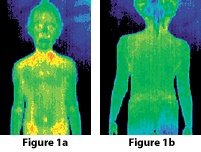
Figure 1: Infrared pictures of the front and the back of a child (51007). The maximum, average, minimum and standard deviation of the temperatures of the face (Figure 1a) are: 93.07 F, 90.97 F, 87.7 F and 0.64 F. The maximum, average, minimum and standard deviation of the temperatures of the upper back (Figure 1b) are 92.43 F, 90.04 F, 88.17 F and 0.64 F.
Next, we look at a male of age 40. He has some neck discomfort, probably due to sitting in front of a computer too long. His infrared picture is presented in Figure 2. His face is not one color and has an average temperature of 92.35 F and a standard deviation 0.82 F. His neck region has an average temperature of 90.25 F, with a standard deviation of 1.29 F. This large standard deviation means his neck is not normal. His upper back region below the neck has an average temperature of 89.96 F, with a standard deviation of 0.47 F.
His face and neck region has three colors including green, yellow and red. They do not have a very hot region or a very cold region. His discomfort is not serious enough to have many treatments. Because he is health-conscious, he worries about it. The worry shows up in the face. His upper back region, which is healthy, has one color: green.
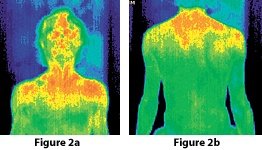
Figure 2: Infrared pictures of the face and the upper back of a 40-year-old male (xhc 51007). The maximum, average, minimum and standard deviation of the temperatures of the face (Figure 2a) are: 94.96 F, 92.47 F, 89.23 F and 0.82 F. The maximum, average, minimum and standard deviation of the temperatures of the upper back near the neck (Figure 2b), where there is some discomfort, are 94.09 F, 90.75 F, 88.52 F and 1.29 F. The maximum, average, minimum and standard deviation of the temperatures of the upper back below the neck are 91.6 F, 89.96 F, 88.52 F and 0.47 F.
Let us discuss the third case of a woman who has serious emotional problems. The infrared pictures of her face and upper back are shown in Figure 3. Her face has an average temperature of 88.77 F, with a standard deviation of 3.78 F. Her upper back has an average temperature of 92.6 F, with a standard deviation of 0.92 F. The two standard deviations, 3.78 F and 0.92 F, are respectively, seven times and two times larger than the normal standard deviation of 0.5 F. This means her emotional problem is serious and requires attention. She does not want to take any medication. She chose to practice qigong daily for three months without any outside help. The duration of daily qigong practice is different each day. It lasts sometimes as long as 1½ hours. She showed a marked improvement in her health. This is shown in Figure 4. Her face now has an average temperature of 89.79 F, with a standard deviation of 0.58 F, and her upper back has an average temperature of 91.53 F, with a standard deviation of 0.46 F. Both of these standard deviations, 0.58 F and 0.46 F, are about the same as the normal standard deviation of 0.50 F of a healthy person.

Figure 3: Infrared pictures of the front and the back of a woman (041707) with emotional problems. The maximum, average, minimum and standard deviation of the temperatures of the face (Figure 3a) are: 93.97 F, 88.77 F, 76.5 F and 3.78 F. The maximum, average, minimum and standard deviation of the temperatures of the upper back (Figure 3b) are 94.64 F, 92.6 F, 89.96 F and 0.92 F.
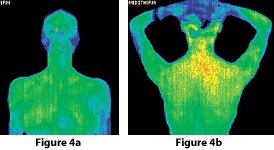
Figure 4: Infrared images of the front and back of a woman with emotional problems after three months of qigong. The maximum, average, minimum and standard deviation of the temperatures of the face (Figure 4a) are: 91.48 F, 89.74 F, 88.17 F and 0.58 F. The maximum, average, minimum and standard deviation of the temperatures of the upper back (Figure 4b) are 93.02 F, 91.53 F, 89.94 F and 0.46 F.
Finally, we come to our cancer patient. His face has an average temperature 96.58 F, with a standard deviation of 0.78 F. His upper back has an average temperature 94.4 F, with a standard deviation of 0.91 F. After a 10-minute treatment with external qi, the average temperature of his face reduces to 92.69 F with a standard deviation of 0.67 F. His face cools down by 3.89 F on average, a most remarkable cooling where only non-touch external qi is administered for 10 minutes. His back also cools down to an average temperature of 91.94 F, with a standard deviation of 0.6 F. The reduction of average temperature of his back is 2.46 F, also a large reduction in a short time interval. After healing by external qi, the standard deviations for the face and the upper back are reduced to 0.67 F and 0.6 F, which are slightly larger than the normal standard deviation of 0.5 F.
We can get a general idea of the condition of the cancer patient by just looking at the color distribution of these pictures. Before healing, the two pictures have a large portion with color, and more than half in red, some in yellow and a small amount of green. After healing, the two pictures are mostly in green, with a small portion of yellow, very little in red, and none in white. The cancer patient's condition is much closer to a normal person after healing than before.
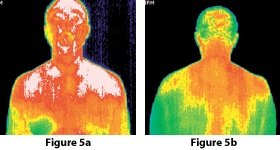
Figure 5: Infrared images of the front and back of a cancer patient. The maximum, average, minimum and standard deviation of the temperatures of the face (Figure 5a) are: 98.2 F, 96.58 F, 93.02 F and 0.78 F. The maximum, average, minimum and standard deviation of the temperatures of the upper back (Figure 5b) are 96.58 F, 94.4 F, 91.01 F and 0.91 F.
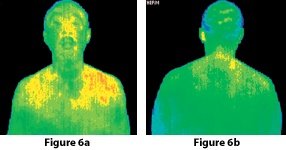
Figure 6: Infrared images of the front and back of a cancer patient after 10 minutes of treatment with external qi. The maximum, average, minimum and standard deviation of the temperatures of the face (Figure 6a) are: 94.64 F, 92.69 F, 90.18 F and 0.67 F. The maximum, average, minimum and standard deviation of the temperatures of the upper back (Figure 6b) are 93.62 F, 91.94 F, 90.3 F and 0.6 F.
Let us generalize the concept of a uniform, common body-surface temperature for good health to a more abstract, universal concept that can be formulated easily in symmetry principles. This is quite common in quantum theory for the physical universe. Let's do it for health. Suppose we have a single pointer that detects the temperature of skin at one point accurately, when it touches the skin. When we move the pointer to different parts of the body, the temperature reading does not change. In other words, the surface temperature of the body remains the same under the translational movement of the pointer. Or simply, the body-surface temperature has translation symmetry. If a person has perfect translation symmetry on his body surface, it implies he has perfect health. Then we have our hypothesis: Perfect symmetry implies perfect health.
No one has perfect symmetry. So we do not find any person's infrared images are in one color only. Symmetry-breaking always occurs for any real object. The relevance of symmetry principles to health are discussed in detail in many articles displayed on my Web site: www.qluni.org, and also in my book, Biophysics Basis of Acupuncture and Health.
If you have perfect health, you have no sickness. You do not age. You will not die. You will live forever. You are said to have perfect gauge symmetry. As soon as gauge symmetry is broken, life is not permanent. The physics behind immortality is the same for humans as for electrons: perfect gauge symmetry. An electron will live forever, as long as it has perfect gauge symmetry. It will decay when exact symmetry is broken. The similarity of symmetry principles for electrons and human beings is extremely fascinating and much more research needs to be done.
From a practical point of view, we can use symmetry principles to examine the temperature of a person in order to evaluate the state of their health. Let us come back to the person with cancer discussed above. The picture of his lower front body is shown in Figure 7. Figure 7a is the picture before healing, which has irregular distribution of many colors. After healing with external qi for 10 minutes, the infrared image of his lower front part is in one green color, with some tiny amounts of blue and yellow. His state of health certainly improves tremendously by external qi. The patient has prostate cancer. So our attention is on his prostate area, in red at Figure 7a. There are plenty of areas that are not green and break the translation symmetry. But after the healing session, translation symmetry is restored to a much greater portion of the picture, which is expressed in green.

Figure 7: Infrared pictures of the lower front of a male cancer patient before (Figure 7a) and after healing with external qi for 10 minutes (Figure 7b). Before healing, the maximum temperature is 97.22 F. After healing, it becomes 94.32 F, a reduction of 2.9 F.
Would you then say the patient returns to health by one healing session of external qi? The answer is, of course not. After the effect of external qi wears out in a day or two, the infrared images would become more like Figure 7a again. Another healing session will have to be performed. Less color variation will be observed and more green color will be restored. The cycle, where more symmetry-breaking is observed before healing and less afterward, will be repeated many, many times. The hope is that translation symmetry will eventually become almost perfect and symmetry-breaking remains small after healing sessions terminate. The infrared image of the patient will essentially be just green, with only a small amount of other colors. The cancer patient will then become healthy again.
Click here for previous articles by Yin Lo, PhD.




